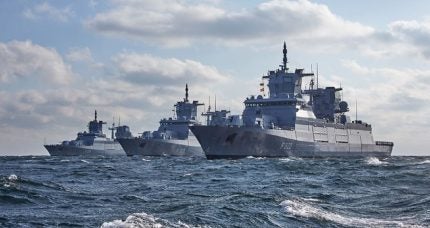
The German Bundeswehr has extended an existing contract for the technical-logistical support (TLS) of the F125 German Navy frigate class for an additional five years until 1 March 2029.
Under this modification, the two German suppliers Thyssenkrupp Marine Systems and the NVL Group – as part of the consortium ARGE F125 – will ensure the operational readiness of all four ships in the class as well as the testing and training centre in Wilhelmshaven in northern Germany.
The F125 is a multi-purpose frigate designed and built by Arge F125 for the German Navy.
Originally designed, built and delivered to the Germany Navy between 2005 and 2022, the four surface combatants can be deployed worldwide for up to two years before returning to the home base. They are capable of operating for up to 5,000 hours a year, even under tropical conditions.
The main mission of the F125 frigate is to take part in joint assignments, including multinational assignments in network-centric operations. The necessity for complementary systems with other navies makes the latest TLS modification all the more necessary.
The main purpose of the contract extension is to continue “maintaining the operational readiness” of the F125 class ships in the face of constantly evolving requirements, Thyssenkrupp commented in a statement.
How well do you really know your competitors?
Access the most comprehensive Company Profiles on the market, powered by GlobalData. Save hours of research. Gain competitive edge.

Thank you!
Your download email will arrive shortly
Not ready to buy yet? Download a free sample
We are confident about the unique quality of our Company Profiles. However, we want you to make the most beneficial decision for your business, so we offer a free sample that you can download by submitting the below form
By GlobalDataUltimately, ARGE F125 deisgned the vessels to replace the Navy’s legacy Bremen-class ships. The concept of the replacement fleet was originally as a multi-purpose combatant, but by 2005, the requirement for the F125 was based on a capability to counter asymmetric threats and perform stabilisation operations with lethal and non-lethal intervention.
“The F125 class will be the backbone of the German Navy’s operational commitments in the coming years. Ensuring the operational readiness of the ships together with the public client is an active contribution to the security policy of… Germany, which we are happy to make,” said Dr. Oliver Juckenhöfel, head of operating unit surface vessels at Thyssenkrupp.
Weighing in at 5,500 tonnes (t), the F125 frigate has a new and stealthy hull and superstructure design, which appears to be based on a highly modified Meko-D configuration. It has an overall length of 149.6 metres (m), a beam of 18.8m and displacement of 7,200t.
Each frigate has two crews comprising 105 to 120 people, who are changed every four months. The number of crew represents an approximate 50% reduction in staff compared with previous generation frigates, achieved partly through a high level of automation.
The frigate also accommodates 50 special forces soldiers and their equipment. Two helicopters or four armed boats can provide the necessary transport.
It is armed with non-lethal weapons such as water cannons and searchlights for non-provocative deterrence and protection.
The ship is also fitted with ten guns, ranging from 12.7 millimetre (mm) to 155mm, allowing fast automatic engagement.
Two quadruple missile launchers for the Boeing RGM-84 Harpoon anti-ship missile are installed on the missile deck, forward of the funnel. The Harpoon missiles are armed with a 227 kilogramme warhead and use active radar homing. The missiles have a high-subsonic speed (Mach 0.9) and a range of up to 130 kilometres.
Currently, Baden-Wurttemberg (F222), the first of the class, is deployed in the United Nations Interim Force in Lebanon.







